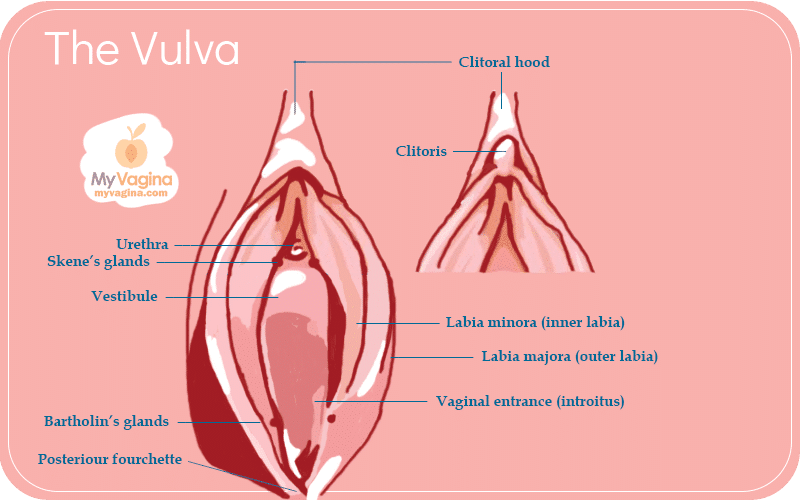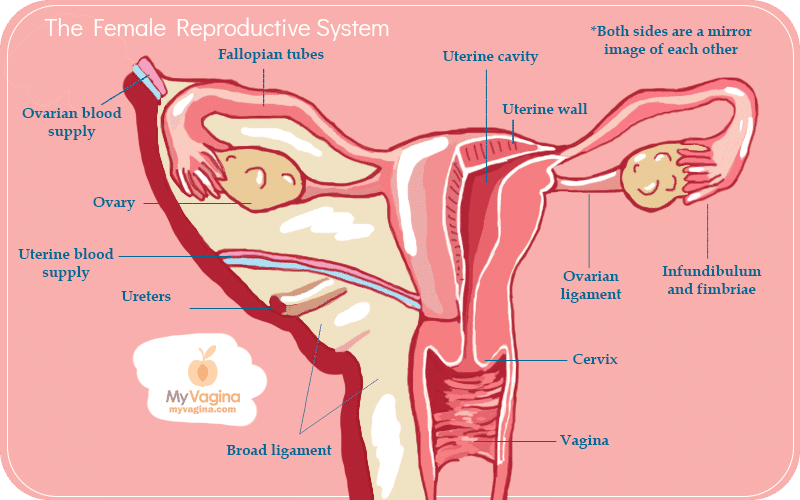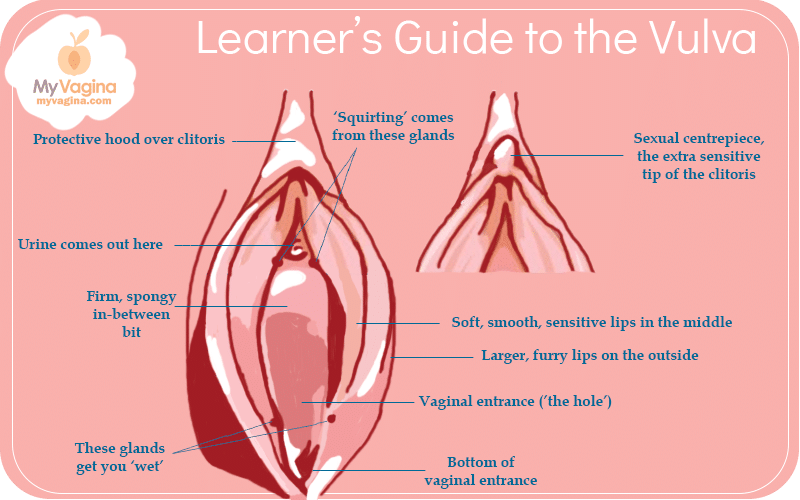What you may know of as the ‘vagina’ may also include the outer parts, the labia and clitoris, which are collectively known as the vulva.
The vagina is the inside part of the body, the hollow, elastic tube, while the vulva is the outer parts that you can see and touch.
Their names are important when we’re explaining things, but we know, it can get all complicated and wordsy.
We’ve made special diagrams so you can see both the proper names for body parts, but the fun things they do too. Learning diagrams has never been so fun!
About the vagina and vulva
The vagina and vulva are jam-packed with blood vessels and nerves, and are unique in so many ways – what a body part! You can put so many things inside a vagina, yet so much can come out of it.
So much pleasure, so much pain, so many things to go right and wrong. The vulva and vagina are distinctly separate, but also very much part of the same system.
Things that can go into a vagina:
- Fingers
- Objects like dildos and vibrators (but also see ‘What not to put inside a vagina‘)
- Tongues (mind the teeth)
- A doctor’s speculum
- Tampons or menstrual cups
- Penises
Things that come out of a vulva or vagina:
- Vaginal secretions (creamy fluid, lubrication, fertile fluids, discharge)
- Urine (out the urethra, which is nestled just above the vaginal entrance)
- Babies
- Menstrual blood
All vaginas and vulvas are slightly different, just like every face is different, but the main bits are always the same (except in the case of an anatomical abnormality or difference in sexual development (DSD)).
Rundown of each part:
Vagina
‘Vagina’ refers to the hollow, muscular tube that penises and toys and fingers go into and that fluids and babies come out of. It is just longer than the middle finger and ends at the cervix, but it changes size considerably depending on the circumstances.
Normally the vagina is slightly tense (contracted) as its normal state, but sexual arousal opens it up somewhat, and childbirth unfolds it completely. It is moist, elastic muscular tube. (Read about vaginal tightness and looseness)
Vulva
‘Vulva’ refers to your ‘outer genitalia’ which means your vaginal lips, the labia majora and the labia minora, plus the clitoris, clitoral hood, and perineum. Your labia (vaginal lips) protect the vagina, but also provide sexual pleasure when touched and stimulated during (good) sex.
Labia
The labia are your ‘flappy’ bits you can see on the outside, with the labia minora the smaller, softer lips that protrude from the thicker, hairy outer lips, the labia majora.
Your labia fill with blood when you are turned on, which helps to make sex better by providing a sensual cushion and protecting against damage. The inner labia often (but not always) protrude somewhat from the outer labia, with the inner and outer labia made from different cells.
The outer labia contain fat cells (to protect), whereas the inner labia are made out of the same cells as testicles, and are much more sensitive. The outer labia are not moist, but the inner labia (inside) are generally gently moistened by normal vaginal fluids.
When aroused, the inner labia fill with blood and may slightly part.
Cervix
The cervix is the entrance to your uterus (womb), and is at the top of your vagina. This is what you can sometimes feel as the end of the line. Nothing much gets through it, and you can’t ‘lose’ anything up there.
It might get stuck for a while, but it can’t go travelling through your body wreaking havoc. (See how to check out your own cervix and how to care for a normal cervix.)
Clitoris
The clitoris is the big organ (that looks small), and swells up with blood when you are aroused. As you can see in one of the diagrams, the clitoris is actually quite big, and is what they think the ‘g-spot’ actually is: the other side of the clitoris.
The clitoris is the essential ingredient for sexual stimulation and orgasm in most women, and as you can see in some of the diagrams, has arms.
In sexual arousal, the clitoris swells with blood and becomes erect just like a penis does. Read more about the clitoris and see pictures here.
Uterus
The uterus (or womb) is a triangle-shaped, hollow muscle that grows endometrial cells on the inside. These endometrial cells ‘bloom’ every month and are what would feed a growing fertilised egg, supporting the growing baby.
If you don’t get pregnant, this lining sheds in what is known as your menstrual period. The endometrium is also prone to disorders and disease, since it is affected by hormones.
Fallopian Tubes
An egg leaves the ovary it came from, and travels down the fallopian tube to the uterus. Eggs are actually fertilised in the fallopian tubes, not the uterus. These tubes are about as big as a piece of skinny spaghetti.
Ovaries
Your ovaries release an egg every month when you ovulate (mid-cycle, the magical ‘Day 14’). This egg travels down the fallopian tube into the uterus.
If it’s fertilised, it will try to implant on the wall of the uterus, but if it isn’t fertilised (most of the time), it simply gets reabsorbed into the body and is excreted out with your menstrual period (blood) as the endometrium sheds.
Mons pubis
This is the name for the pubic bone that shields the entire vagina, and upon which a fatty layer lies and pubic hair grows.
Hymen
The hymen is a thin covering of the vaginal entrance most commonly found in younger girls, but which may persist until adulthood in the absence of sexual intercourse, use of tampons or other activities (sports, horse-riding, etc.) that may stretch the opening. Read about the hymen here.
Urethral opening
The urethra is the tube that carries your urine from your bladder to the toilet, with the opening sitting inside the vulva (see diagrams).
Vulva and vagina diagrams







